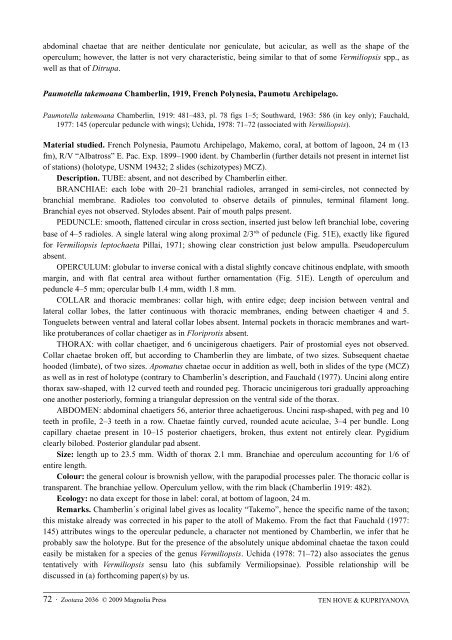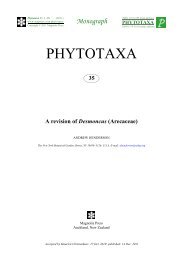Zootaxa, Taxonomy of Serpulidae (Annelida ... - Magnolia Press
Zootaxa, Taxonomy of Serpulidae (Annelida ... - Magnolia Press
Zootaxa, Taxonomy of Serpulidae (Annelida ... - Magnolia Press
You also want an ePaper? Increase the reach of your titles
YUMPU automatically turns print PDFs into web optimized ePapers that Google loves.
abdominal chaetae that are neither denticulate nor geniculate, but acicular, as well as the shape <strong>of</strong> the<br />
operculum; however, the latter is not very characteristic, being similar to that <strong>of</strong> some Vermiliopsis spp., as<br />
well as that <strong>of</strong> Ditrupa.<br />
Paumotella takemoana Chamberlin, 1919, French Polynesia, Paumotu Archipelago.<br />
Paumotella takemoana Chamberlin, 1919: 481–483, pl. 78 figs 1–5; Southward, 1963: 586 (in key only); Fauchald,<br />
1977: 145 (opercular peduncle with wings); Uchida, 1978: 71–72 (associated with Vermiliopsis).<br />
Material studied. French Polynesia, Paumotu Archipelago, Makemo, coral, at bottom <strong>of</strong> lagoon, 24 m (13<br />
fm), R/V “Albatross” E. Pac. Exp. 1899–1900 ident. by Chamberlin (further details not present in internet list<br />
<strong>of</strong> stations) (holotype, USNM 19432; 2 slides (schizotypes) MCZ).<br />
Description. TUBE: absent, and not described by Chamberlin either.<br />
BRANCHIAE: each lobe with 20–21 branchial radioles, arranged in semi-circles, not connected by<br />
branchial membrane. Radioles too convoluted to observe details <strong>of</strong> pinnules, terminal filament long.<br />
Branchial eyes not observed. Stylodes absent. Pair <strong>of</strong> mouth palps present.<br />
PEDUNCLE: smooth, flattened circular in cross section, inserted just below left branchial lobe, covering<br />
base <strong>of</strong> 4–5 radioles. A single lateral wing along proximal 2/3 rds <strong>of</strong> peduncle (Fig. 51E), exactly like figured<br />
for Vermiliopsis leptochaeta Pillai, 1971; showing clear constriction just below ampulla. Pseudoperculum<br />
absent.<br />
OPERCULUM: globular to inverse conical with a distal slightly concave chitinous endplate, with smooth<br />
margin, and with flat central area without further ornamentation (Fig. 51E). Length <strong>of</strong> operculum and<br />
peduncle 4–5 mm; opercular bulb 1.4 mm, width 1.8 mm.<br />
COLLAR and thoracic membranes: collar high, with entire edge; deep incision between ventral and<br />
lateral collar lobes, the latter continuous with thoracic membranes, ending between chaetiger 4 and 5.<br />
Tonguelets between ventral and lateral collar lobes absent. Internal pockets in thoracic membranes and wartlike<br />
protuberances <strong>of</strong> collar chaetiger as in Floriprotis absent.<br />
THORAX: with collar chaetiger, and 6 uncinigerous chaetigers. Pair <strong>of</strong> prostomial eyes not observed.<br />
Collar chaetae broken <strong>of</strong>f, but according to Chamberlin they are limbate, <strong>of</strong> two sizes. Subsequent chaetae<br />
hooded (limbate), <strong>of</strong> two sizes. Apomatus chaetae occur in addition as well, both in slides <strong>of</strong> the type (MCZ)<br />
as well as in rest <strong>of</strong> holotype (contrary to Chamberlin’s description, and Fauchald (1977). Uncini along entire<br />
thorax saw-shaped, with 12 curved teeth and rounded peg. Thoracic uncinigerous tori gradually approaching<br />
one another posteriorly, forming a triangular depression on the ventral side <strong>of</strong> the thorax.<br />
ABDOMEN: abdominal chaetigers 56, anterior three achaetigerous. Uncini rasp-shaped, with peg and 10<br />
teeth in pr<strong>of</strong>ile, 2–3 teeth in a row. Chaetae faintly curved, rounded acute aciculae, 3–4 per bundle. Long<br />
capillary chaetae present in 10–15 posterior chaetigers, broken, thus extent not entirely clear. Pygidium<br />
clearly bilobed. Posterior glandular pad absent.<br />
Size: length up to 23.5 mm. Width <strong>of</strong> thorax 2.1 mm. Branchiae and operculum accounting for 1/6 <strong>of</strong><br />
entire length.<br />
Colour: the general colour is brownish yellow, with the parapodial processes paler. The thoracic collar is<br />
transparent. The branchiae yellow. Operculum yellow, with the rim black (Chamberlin 1919: 482).<br />
Ecology: no data except for those in label: coral, at bottom <strong>of</strong> lagoon, 24 m.<br />
Remarks. Chamberlin´s original label gives as locality “Takemo”, hence the specific name <strong>of</strong> the taxon;<br />
this mistake already was corrected in his paper to the atoll <strong>of</strong> Makemo. From the fact that Fauchald (1977:<br />
145) attributes wings to the opercular peduncle, a character not mentioned by Chamberlin, we infer that he<br />
probably saw the holotype. But for the presence <strong>of</strong> the absolutely unique abdominal chaetae the taxon could<br />
easily be mistaken for a species <strong>of</strong> the genus Vermiliopsis. Uchida (1978: 71–72) also associates the genus<br />
tentatively with Vermiliopsis sensu lato (his subfamily Vermiliopsinae). Possible relationship will be<br />
discussed in (a) forthcoming paper(s) by us.<br />
72 · <strong>Zootaxa</strong> 2036 © 2009 <strong>Magnolia</strong> <strong>Press</strong><br />
TEN HOVE & KUPRIYANOVA
















